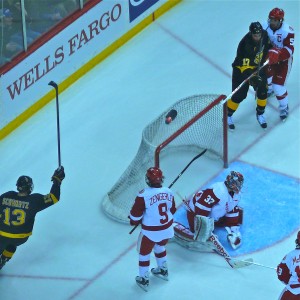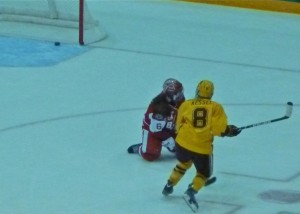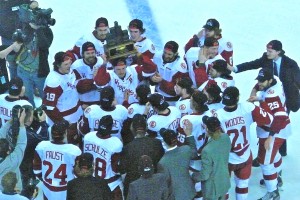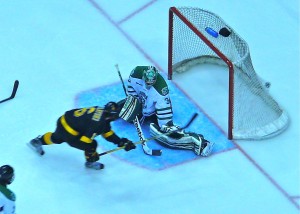WCHA sends 6 to NCAA in Final Flourish
By John Gilbert
The Western Collegiate Hockey Association is not dying after this season, it just seems that way. The most successful conference in any sport is exploding to form three different leagues, while the rival CCHA is also going to be shattered, with the remnants joining what will remain of the WCHA to make up the WCHA as of next fall.
To briefly explain: Minnesota and Wisconsin were forced to join Michigan, Michigan State, Ohio State and Penn State in a new Big Ten hockey conference. The Big Ten says any time as many as six of its member schools play a sport, that sport must be a Big Ten league. With Penn State starting hockey — and the Nittany Lions upset Wisconsin in Madison for a split late this season! — that was the sixth Big Ten team. That caused some unrest and instability within the remaining WCHA entries, and North Dakota and Denver led an insurrection to start a new league.
Denver and North Dakota coerced Colorado College, Nebraska-Omaha, and Miami of Ohio to start the new National Collegiate Hockey Conference (NCHC), and UMD had to choose quickly, and jumped on board. That made for a six-team elitist league, which added St. Cloud State and Western Michigan to make eight.
That leaves Bemidji State, Minnesota State-Mankato, Michigan Tech, Northern Michigan, Lake Superior State, Alaska-Anchorage, Alaska-Faribanks, Bowling Green, and Ferris State in an interesting league, and Alabama-Huntsville joined as well, making 10. That group will still be called the WCHA, which is great, because historically it will give the new league a standard to strive for.

CC's Rylan Schwartz (13) set up Charlie Taft for a goal on Joel Rumpel, but Wisconsin won the WCHA title game 3-2.
All of that means that the WCHA’s Final Five last weekend was loaded with historical significance. And it was also loaded with surprises and upsets. Wisconsin beat Colorado College 3-2 in the championship game, which can be called the “final Final Five final.” The title game had added drama, because all the computer calculations said that while the winner would get the automatic berth in the NCAA tournament’s 16-team field, the loser would not make it. Both finalists had played two amazing games to reach the final. Wisconsin stunned MSU-Mankato 7-2, then shocked No. 1 seed St. Cloud State 4-1, while Colorado College — which finished eighth in the regular season WCHA race — knocked off North Dakota in overtime, then played a magnificent game to beat Minnesota 2-0. Rarely does a team succeed having to win a quarterfinal, the beat a bye team in the semifinals, and then win the third game in three days. But in this case, both teams had to play their third game in three days, and because CC’s games were far more grueling than Wisconsin’s, the Tigers seemed more worn out in the final, but played with great heart, and the spark of Rylan Schwartz, to challenge the Badgers. Wisconsin obviously deserved to reach the NCAA, having eliminated UMD in two straight, then Mankato, St. Cloud and CC.
The Badgers, with their shut-down style and opportunistic offense, have freshman Nic Kerdiles and Tyler Barnes as first-team wingers who have amazing chemistry for finding each other with passes. As the 14th seed, lowest among WCHA entries, the Badgers are a legitimate threat to win the Northeast Regional and make a run at the NCAA title.
But the most impressive team in the Final Five was Colorado College, both for the grit and tenacity they showed in beating Denver by winning two games after losing the first, and then taking out North Dakota in overtime, but mostly for the flawless, free-flowing offense that left the Golden Gophers looking more befuddled than any co-champ should look in the 2-0 semifinal.
The worst call of the tournament came in the first period of Wisconsin’s 4-1 victory over St. Cloud State. A 2-on-1 rush, with a shot from the right side blocked by Badger goalie Joel Rumpel, with the rebound landing in the slot. As Nic Dowd shot the rebound toward the open goal, Rumpel turned from the congestion of the shooter and his defenseman, pulled his stick free, and whirled to try to get in the way of Dowd’s shot. No chance. So Rumpel let his stick slide, knob-first, from his grasp, diagonally across the crease toward the left post. Incredibly, Dowd’s shot hit the handle of the stick and slid just centimeters wide of the left pipe. Had Dowd scored, St. Cloud would have led 2-1 at the second intermission.
St. Cloud State coach Bob Motzko discussed it with the referees, who agreed to check with Greg Shepherd, supervisor of officials, upstairs manning the video replays. The rule book doesn’t say such a play is a penalty — it is a goal, anytime a player throws or slides his stick to prevent the puck from obviously going into the goal! AAfter repeated viewings, the ruling was no goal. I asked Shep about it, and he said one replay showed that Rumpel’s stick hit his teammate’s skate, which knocked the stick out of his hand, meaning he didn’t throw it. We had a pretty good argument about it, but I saved my coup de grace for the end. In the interview room, Rumpel said: “I guess I kind of dove and it hit the knob of my stick, and knocked it out of my hand. But the puck just skirted wide.” For clarification, I raised my hand and asked: “Are you saying another player knocked the stick out of your hand?” And Rumpel said: “No, nothing hit my stick, except the puck.” I told Shepherd he had to call it the way he saw it, but the goaltender himself acknowledged he threw his stick at the puck, and was quite jovial about accepting credit for the accuracy of his “Olympic Stick Slide.”
Badger coach Mike Eaves said, simply: “Obviously, it was the turning point in the game.”
SIX WCHA TEAMS MAKE NCAA
The last hurrah for the WCHA as we know it should be a good one, because six WCHA teams made the 16-team NCAA field, which begins with four regionals this week. On Friday, the show starts with Minnesota facing Yale at 1 p.m. in Grand Rapids, Mich., followed by the North Dakota-Niagara game at 4:30. Don’t look ahead, but very likely we’ll see a Minnesota-North Dakota showdown at 3 p.m. Saturday in that West Region final — two teams that are leaving the WCHA for new horizons next year.
The Northeast Regional follows with Wisconsin facing Massachusetts-Lowell at 3:30 in Manchester, N.H., followed by Denver facing New Hampshire at 7 p.m. Those winners meet at 5:30 p.m. Saturday.
The other two regionals are Saturday-Sunday, with the East Regional pitting top overall seed Quinnipiac against Canisius in an odd match between two programs that were basically not on the horizon of elite teams three or four years ago. That will be at 5:30 p.m. Saturday in Providence, R.I., and will be followed at 8 p.m. by Boston College facing Union. Those winners play at 3 p.m. Sunday in the only region that doesn’t have a WCHA team, because the NCAA will do anything to avoid the situation a few years ago when all four Frozen Four teams were from the WCHA. Frankly, it was no fun; more like a rerun of the WCHA Final Five.
The Midwest Regional in Toledo has Notre Dame facing St. Cloud State at 12:30 Saturday, followed by Miami facing MSU-Mankato at 4 p.m. The winners meet for a Frozen Four berth at 3 p.m. Sunday. That’s an interesting region, because Notre Dame and Miami, both leaving the CCHA, will be favored over the 11th-seeded MSU Mavericks, and the No. 13 seeded St. Cloud State Huskies. But both the Mavericks and the Huskies have dangerously talented teams, and have the unique opportunity to make up for disappointing showings in the Final Five. And upset or two there, wouldn’t surprise me.
One thing about the NCAA’s convoluted ratings and computer calculations that has bothered me for a couple of decades. All of that computer stuff and Pairwise calculations are impressive. But the NCAA should be made aware of this thing each league has, called “Standings.” Nonconference games are important, but they are too important with the computer involvement. Used to be that teams could play a few back-up players in nonconference games; now they have to play them for keeps. To me, the conference standings are all-important, and should be given extra weight in the computer input. In the WCHA, St Cloud State was caught and tied for co-championship by Minnesota in the last game of the season, but St. Cloud State was No. 1 seed on tie-breakers. My plan would have each league submit its standings — including league tournaments, if they wish. In the WCHA, St. Cloud State would rank No. 1, Minnesota No. 2, North Dakota No. 3, etc. That’s the way they finished in their tough and exhausting league race. There should be no computer that can say that Minnesota, North Dakota, Denver, and MSU-Mankato should be seeded higher than St. Cloud State — the league’s top seed.
It would, however, be great to see the WCHA as we know it supply a couple of Frozen Four teams and win the national championship as its own going-away gift to the WCHA.
GOPHER WOMEN WIN TITLE AT 41-0
The University of Minnesota women’s team completed a pressure-filled playoff by loosening up and playing its game to beat Boston University 6-3 in the NCAA championship game Sunday at Ridder Arena. A sold-out Ridder Arena, with 3,500 fans jammed in, saw the Gophers become the only women’s team to ever go all the way through the season undefeated and untied, at 41-0. Their winning streak is now at 49 and counting, with their second straight title. Amanda Kessel, the Kazmaier Award winner, finished a brilliant season with two goals and two assists, giving her 46-45–101 for the season.

Amanda Kessel's 2nd goal, 46th of the year, enters empty BU goal to clinch 6-3 NCAA final victory for Minnesota.
That victory followed two very tough games, with the Gophers surviving a triple-overtime quarterfinal before beating North Dakota, then getting past Boston College 3-2 in overtime in the semifinal. The weight of the undefeated season started to get a little heavy once Minnesota got to elimination games, which made the title game a relaxed and relieved performance.
The media, most of which had never paid any proper attention to women’s hockey, jumped all over the bandwagon to claim that this Gopher team is the greatest women’s team ever. I say this team has the greatest record of all, but it can’t be assumed it’s the best team ever. Its statistics are impressive: Kessel’s 46-55–101 is followed by Michelle Brandt’s 33-49–82, and ace defenseman Megan Bozek’s 20-37–57. And senior goaltender Noora Raty has been positively brilliant.
It is apparent that this Gopher team is among the best ever, but let’s look back at the repeat Gopher title-winning teams of 2003-04, and 2004-05. In those years, UMD was also a truly elite power, having won the first three NCAA titles, in 2000, 2001, and 2002. They were still loaded with elite players in the years the Gophers won, and Wisconsin was coming on strong, with a roster full of players that would win the following two titles.
In 2004-05, for example, the Gophers were 36-2-2 overall, compared to this year’s 41-0, and they were 25-1-2 in WCHA play, compared to this year’s 28-0. The difference is that beat the Gophers in league play, and UMD and Wisconsin each pinned ties on the Gopher record. North Dakota and Wisconsin were pretty strong this year, while UMD and Ohio State were a notch back, but none of those four approached the elite quality of UMD, and the emerging Badgers, of a decade ago. That accounts for the slight difference in losing a game or two and going undefeated.
Look also at the team statistics. In the 04-05 title year, Minnesota’s top three scorers were Natalie Darwitz, with 42-72–114, Krissy Wendell, with 43-61–104, and Kelly Stephens, with 33-43–76. Those were in 40 total games. In all-time Gopher scoring, Darwitz has 102-144–246 in 99 games; Wendell 106-131–237 in 101 games; and Stephens 97-121–218 in 148 games. Nadine Muzerall, who played with Darwitz and Wendell on the 2003 title team, amassed 139-96–235 in 129 games.
Kessel has 97-134–231 for her three years so far, in 113 games. Kessel is joining the U.S. team for the World Championships right now, and is a cinch to make the U.S. Olympic team, which will take her away from the Gophers for a season. When she comes back, she is certain to pass Muzerall, and Stephens, Wendell and Darwitz to become the top Gopher scorer of all time. But before we anoint her as the best ever, let’s appreciate that like Kessel, Wendell and then Darwitz were chosen outstanding players of the 2003 and 2004 NCAA Frozen Fours, respectively, with Darwitz scoring 3-6–9 in the 2004 event.
In the meantime, we also cannot look beyond those first three UMD teams, all of which won the NCAA titles. in 1999-2000, the Bulldogs went 25-5-3, with a 21-1-2 record in the WCHA. In ’99-2000, Jenny Schmidgall led the league with 41-52–93, with Minnesota’s Muzerall the top goal-scorer at 49-28–77 in second, and then came UMD’s Maria Rooth 37-31–68, and Hanna Sikio 25-39–64. In WCHA play, the top four UMD scorers were Schmidgall (who became Jenny Potter) 36-46–82; Rooth 31-28–59; Sikio 22-32–54, and Erika Holst 23-18–41. At the end of the Schmidgall/Potter-Rooth years, along came Caroline Ouellette, another elite player. We also should point out that while Potter was the best player on the U.S. women’s teams for several years, until Darwitz and Wendell came along to give the U.S. three superstars, Rooth was clearly the best player on Sweden’s national and Olympic teams, as was more recent UMD goaltender Kim Martin, who beat the heavily favored Team USA in the 2006 Olympics, while Sikio and goaltender Tuula Puputti were brilliant for Finland, and Ouellette became the best player on Canada’s Gold Medal teams.
We could go on, and evaluate the stars at Wisconsin during the four Badger championship years — one of which included only one loss (to UMD) and two ties. Suffice it to say that Amanda Kessel may play up to the amazing standards Potter, Darwitz and Wendell have set for the U.S. in international play, and this year’s undefeated Gopher team is definitely at the level of those Darwitz-Wendell Gopher teams, and the Potter-Rooth-Ouellette Bulldog teams, and the elite Badger teams.
It’s certainly not Minnesota’s fault that the competition was a definite cut below the level that featured the Gophers, Bulldogs and Badgers all with elite teams that would take turns beating each other. Nobody could go undefeated in those seasons. But coach Brad Frost has maintained the flow of elite players to the Gophers, while UMD and Wisconsin have run thin in that department. The Gophers, without question, deserve all the accolades of their fantastic unbeaten, untied season, but those who have just discovered women’s college hockey should be cautious about declaring them the best ever.
Comments
Tell me what you're thinking...
and oh, if you want a pic to show with your comment, go get a gravatar!





 John Gilbert is a lifetime Minnesotan and career journalist, specializing in cars and sports during and since spending 30 years at the Minneapolis Tribune, now the Star Tribune. More recently, he has continued translating the high-tech world of autos and sharing his passionate insights as a freelance writer/photographer/broadcaster. A member of the prestigious North American Car and Truck of the Year jury since 1993. John can be heard Monday-Friday from 9-11am on 610 KDAL(www.kdal610.com) on the "John Gilbert Show," and writes a column in the Duluth Reader.
John Gilbert is a lifetime Minnesotan and career journalist, specializing in cars and sports during and since spending 30 years at the Minneapolis Tribune, now the Star Tribune. More recently, he has continued translating the high-tech world of autos and sharing his passionate insights as a freelance writer/photographer/broadcaster. A member of the prestigious North American Car and Truck of the Year jury since 1993. John can be heard Monday-Friday from 9-11am on 610 KDAL(www.kdal610.com) on the "John Gilbert Show," and writes a column in the Duluth Reader.